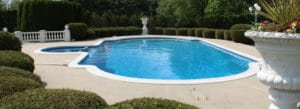Looking for a Pool Plaster contractor licensed in Pennsylvania? Look no further than Coronado’s Pool Renovations of Souderton PA!
Pool plastering is far more complicated than most people think, ask those who’ve tried to do it themselves. Apart from finding the right tone for the surfaces, you have to think about performance over time and must make considerations for problems such as etching, nodule formation, and scaling. You must also work hard to reduce, or if possible, eliminate staining, spotting, and general surface deteriorations.
According to expert advice, the following list of nine steps MUST be followed for quality pool plastering.
- The cement to aggregate (marble) ratio must be 1:1.5 – 1.75. Plaster that is too rich tends to shrink and crack fast while that which is too lean is not durable and may be unworkable.
- The water to cement ratio must be maintained at 0.50. It’s been observed that a ratio of less than 0.50 provides stronger, acid-resistant pool finishes. However, such low ratios have also been associated with increased density, reduced permeability and an increased tendency to shrink and eventually crack.
- The quantity of calcium chloride set-accelerant should be controlled. Actually, this amount should never exceed 2 percent of the quantity of cement. If working with colored calcium, you must NOT use calcium chloride.
- Plaster mixtures should be mixed thoroughly, but never for too long. Experts advise against mixing plaster for longer than 90 minutes.
- Water should never be added to the plaster while troweling. The American Concrete Institute which is a member of the National Plastering Council says that doing so increases porosity and may also induce spotting, shrinkage, and discoloration.
- While well-timed troweling helps with strengthening plaster surfaces, late hard-troweling has been observed to cause spotting and discoloration especially where calcium chloride is used.
- Plastering in extreme weather is discouraged as it causes durability problems. To avoid this, many plastering companies now “tent” the pools when plastering.
- After the plastering has been completed, wait for at least six hours before filling the pool with water. And avoid filling the pool aggressively as this may damage new plaster surfaces.
- Balanced water chemistry helps preserve plaster surfaces. Once you’ve filled your pool, balance the water and keep it that way.
Summary
Coronado’s Pool Plasters are certified pool plaster applicators with 25 years of experience. Call us today on 215-723-5885 for more information or to ask for a quote.
Fill out the form below and one of our team members will get back to you as soon as possible!





